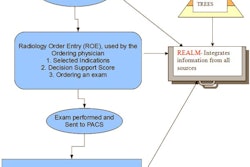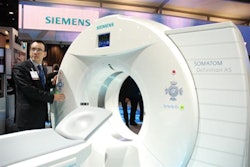An integrated delivery network in Seattle achieved a more than 20% reduction in the number of orders for three commonly performed imaging exams by implementing internally developed decision-support software, according to an article in the January issue of the Journal of the American College of Radiology.
What's more, researchers at Virginia Mason Medical Center found that it wasn't necessary to deploy clinical decision-support software at the same time as a computerized physician order-entry (CPOE) system to achieve impressive results in permanently reducing exam volume for the three procedures (JACR, Vol. 8:1, pp. 19-25).
By identifying when CT and MRI exams would have little to no treatment value for patients presenting with migraine headaches, sinusitis, and lower back pain, Virginia Mason reduced exam volume for related CT and MRI exams by 23% to nearly 27%.
The success of this initial program prompted Virginia Mason to expand decision support to 13 additional CT and MRI procedures, with protocols for another two CT exams to be implemented in the first quarter of 2011.
How decision support evolved
The decision to implement decision support emerged from discussions by Virginia Mason Medical Center executives with key customers, major employers, and health insurance plans serving the Seattle-Tacoma Puget Sound area. The discussions were among the first of what Virginia Mason calls a "marketplace collaborative" that found the facility working with its customers to identify targets for improvement to provide appropriate, affordable, and profitable healthcare, according to Robert Mecklenburg, MD, medical director of Virginia Mason's Center for Health Care Solutions and a co-author of the study.
In an interview with AuntMinnie.com, Mecklenburg said that its customers identified three target areas where patient outcomes and cost reduction could be improved: lower back pain, migraine headaches, and sinusitis. In its analysis of costs charged to treat these conditions, advanced imaging procedures were identified as a major contributor.
The radiology department felt that if well-established, evidence-based guidelines were followed when lumbar MRI exams for lower back pain and head MRI for headaches were ordered, it could eliminate exams that do not provide any diagnostic benefit. These exams were expensive and frequently performed, but had high variability in utilization among primary care physicians.
By 2005, Virginia Mason had implemented an enterprise-wide CPOE system, which included a computerized radiology scheduling system, and decided to include decision-support protocols in the software. Referring physicians would be required to fill out computerized forms when ordering imaging studies; if the order did not match decision rules developed at the institution, it would be denied.
Instead of imaging, physicians could order clinical interventions for low back pain that included physical therapy and a consultation with a spine specialist. Patients with headaches or sinus disease could have a consultation with a neurologist or allergist. Specialists could override the clinical decision-support system if they felt an imaging procedure was clinically indicated for a patient.
The decision-support system was implemented in 2005 for MRI for back pain and headaches, and it was expanded to include a protocol for sinus CT in 2007.
What it accomplished
After implementation of each decision-support protocol, utilization rates for the targeted exam dropped dramatically, by 23.2% for a headache head MRI, 23.4% for a low-back-pain lumbar MRI, and 26.8% for a sinusitis sinus CT. With the exception of MRI of the lumbar spine, which increased at a rate of approximately 3% per year from 2006 through 2009, the utilization rate decreases have remained constant, reported radiologist Craig Blackmore, MD, lead author on the study.
To perform their analysis and to calculate imaging utilization, the authors queried the data records of a large regional health insurance carrier with respect to CPT codes, as well as its own radiology information system. Calculating the utilization of clinical interventions -- i.e., physical therapy and specialist consultations -- was beyond the scope of this retrospective study.
However, Mecklenburg told AuntMinnie.com that decision-support implementation was very cost-effective, and that there was excellent acceptance from healthcare providers. "Since the first three [decision-support] protocols, we've done many similar marketplace collaborations with employers and payors, and this has led us to add additional noncontroversial and well-established, evidence-based guidelines for advanced imaging," he said.
The department added protocols for head CT shortly thereafter, attacking another big contributor to imaging costs. Musculoskeletal imaging was another focus, with decision-support protocols added for MRI exams of the cervical spine, thoracic spine, hip, ankle, elbow, foot, shoulder, knee, wrist, and hand. Protocols for abdominal and pelvic CT exams will be added soon, Mecklenburg said.
Virginia Mason's success in reducing imaging procedures and substituting clinical interventions in their place has been made easier by the fact that all clinicians and clinical support staff are salaried employees of the integrated delivery network. As employees, radiologists could participate in practice improvements without concern about the effects of decreased reimbursement on their department.
Rapid access to specialists and other clinicians who provided the clinical interventions was easy in this environment. And Virginia Mason's institutional culture, which includes a pervasive focus on efficiency and lean healthcare management methodology, provided a strong framework to enable relatively rapid change, the authors wrote.
The fact that the decision-support protocols are internally developed may also contribute to acceptance. A multidisciplinary team is responsible for providing and updating the protocols, which are then thoroughly vetted. "We haven't adopted any protocols based on opinion, only evidence-based medicine," Mecklenburg said. "Our physicians continually review all relevant literature to identify new protocols and update existing ones."
Although the decision-support system is expanding, Virginia Mason has no interest in converting to commercially available decision-support software. After the protocol development team created the decision-support forms, Mecklenburg estimated that it took less than a day's time for IT department staff to integrate the decision-support system with its CPOE. In addition to not having to purchase decision-support software and upgrades, there's no additional cost of maintaining a separate IT system, Mecklenburg explained. Virginia Mason does not need many of the features offered by commercial systems, he said.
As for offsetting lost revenue from eliminated imaging procedures, it has been more than compensated by increased volume from patients who are receiving less expensive and more appropriate healthcare treatments.
"To give you one example, the throughput through our back pain clinic has made our services more accessible to patients," Mecklenburg said. "Our volume for the number of patients with low back pain has quadrupled in several years, and has more than offset revenue for lost lumbar MRI exams. Treatment is less expensive for our customers, the payors. The strategy of providing evidence-based care in a timely manner at a lower cost is good business for Virginia Mason, good business for employers, good business for payors, and good healthcare service for our patients."
In December 2010, Virginia Mason Medical Center was named one of two "top hospitals of the decade" by the Leapfrog Group, a management and consulting firm that conducts an annual survey to assess more than 1,200 participating hospitals' quality and safety programs and outcomes. In November 2010, CRC Press/Productivity Press published Transforming Health Care: Virginia Mason Medical Center's Pursuit of the Perfect Patient Experience by Charles Kenney. The book includes an anecdotal discussion about using clinical decision-support software when ordering advanced imaging exams.
By Cynthia E. Keen
AuntMinnie.com staff writer
January 5, 2011
Related Reading
Decision-support software has practice-changing implications, November 28, 2010
CMS unveils imaging decision-support initiative, July 23, 2010
One-quarter of outpatient CT and MRI exams are inappropriate, March 1, 2010
Copyright © 2011 AuntMinnie.com



















